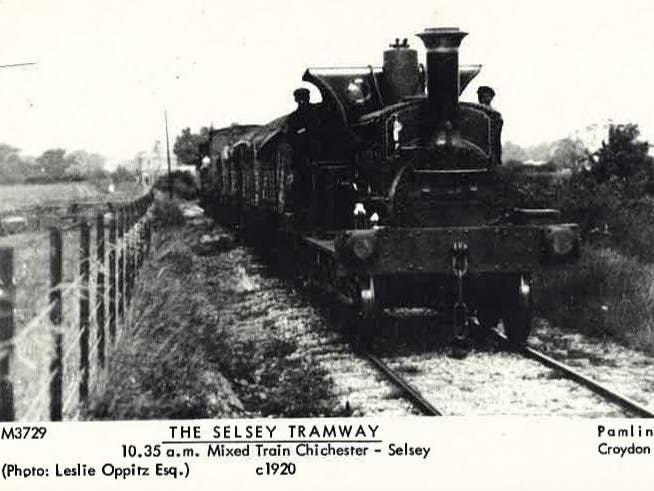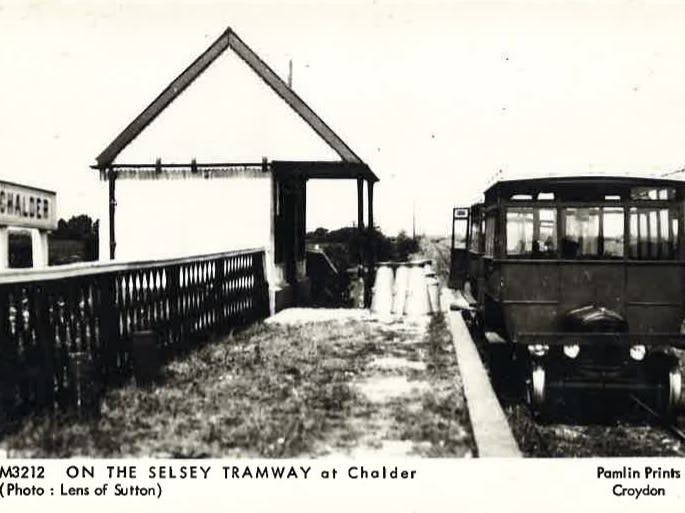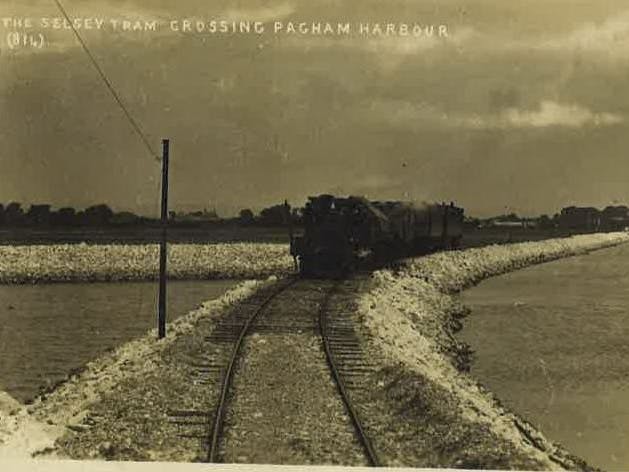The Selsey Tramway
It is hard to imagine how just isolated Selsey was as a place in the late 19th Century. Sitting 8 miles south of Chichester, horse drawn carriages were the most used form of transportation for both people and goods. If you did not own a horse, the only alternative was to walk. In the 1870s there was only one local carrier, Mr Fidler, whose journey to Chichester took two hours – longer on the return trip if he popped into a public house!

The passing of the Light Railways Act in 1896 raised the possibility for local businessmen to look at whether a rail connection could be made. Investigations led them to the formation of The Hundred of Manhood and Selsey Tramway Company, incorporated on 29th April 1896. In preparation of the scheme, it was discovered that they could structure the line as a tramway as opposed to a railway and therefore avoid the special safety arrangements for the numerous public road level crossings required by a railway. And so the Selsey Tramway was born.
Land was acquired from landowners, happy to co-operate, and so the need for compulsory purchasing powers was not required. The negotiation did however necessitate the need for the tram line to hug existing field edges causing the line to twist and turn with very tight bends, so tight that speeds of over 15mph were banned. The cost of this land purchase and the construction of the line was £21,570 and the project was overseen by light railway entrepreneur Holman F Stephens. Work began in May 1897 with 100 men employed to lay the line and with the purchase of rolling stock at a cost of £3,268, the Selsey Tramway was officially opened on 27th August 1897.
The tramway station in Chichester was located on the south side of the main line and upon leaving the station, took a sharp left to cross Stockbridge Road, a loud whistle was the only warning to other road users. From here, the train moved to cross the Chichester Canal at Hunston where a manually operated bridge was in action, allowing barges to pass.

The stops on the line were as follows:
- Chichester
- Hunston – a tiny iron building and a little platform but an important stop as it was here that a coaling and water depot were based
- Hoe Farm – this was a private halt on the journey, specifically for the farm owner
- Chalder – the access for this stop was over a private farm road, the landowner was paid £2 per year to allow the tramway to cross
- Mill Pond – This was the closest station to Sidlesham village
- Sidlesham (ancient spelling Siddlesham) – actually some distance south of the village
- Ferry
- Golf Club – another private halt on the journey for the landowner or private golfers
- Selsey Bridge – the only bridge on the line
- Selsey Town (renamed Selsey in 1911) – an engine shed was located here with a goods siding
- Selsey Beach – an extension to the line which opened 1st August 1898 and closed in October 1904. This service operated during the summertime only.
At the height of the tramway, there were eleven trains each way on Monday to Saturday and six on a Sunday, these carrying over 102,00 passengers per year. Costing 7 ½ d for a single trip and 1 shilling 3d for a return, the journey between Chichester and Selsey took around 30 minutes and was purported to run to a timetable although in reality this would depend upon local circumstances. In the late summer, the tram would even stop in appropriate locations to allow the passengers to get off and pick blackberries. Delays could also be caused by animals on the line, weather issues or broken down engines as the rolling stock was often second hand and past their best.

The following locomotives were used on the line:
| Name | Years on Selsey Tramway | Buider and Date of Build | History |
| Selsey | 1897 - 1935 | Pecket and Sons -1897 (rebuilt in 1899 with larger tanks and a modified coal bunker) | Built specifically for The Selsey Tramway |
| Chichester (first) | 1897 - 1913 | Longbottom Railway Foundary - C1865 | 50 years service on the Great Western Railway |
| Sidlesham | 1907 - 1930 | Manning Wardle - 1861 (extensively rebuilt and overhauled by Hawthorn Leslie & co.) | Ex industrial |
| Hesperus | 1912 - 1224 | Neilson - 1871/2 | Ex Plymouth Devonport and South Western railway |
| Ringing Rock | 1917 - 1935 | Manning Wardle - 1883 | Ex industrial |
| Chichester (second) previously Wembley | 1919 - 1932 | Hudswell Clarke - 1903 | Ex industrial |
| Morous | 1924 - 1935 | Manning Wardle - 1866 | Stratford-on-Avon and Midland Junction Railway then Shropshire and Montgomeryshire light railway |

Attached to these engines were a variety of coaching stock, again mainly purchased as second hand coaches from other railways such as the Lambourn Valley Railway in Berkshire, the London, Chatham and Dover Railway and Southern Railway.
Between the first and second World Wars, a number of ex main line railway coaches were purchased by private individuals to be converted into homes in Selsey. These travelled via the Selsey Tramway to their final destination and some can still be seen in Selsey today, find out more here.
15th December 1910 brought a fierce and prolonged storm which culminated in a breach of the sea wall. 2000 acres of land were flooded in less than an hour. Eventually, between 4000 and 5000 acres of land were submerged and this included the tramline between Sidlesham and the Ferry, parts of the line and Sidlesham Station platform were under 12 feet of water in places. The company had been running as a relatively prosperous business and as such had the resources to raise the line by over 3m in this area as well as build an embankment two-thirds of a mile long and between 12 and 15ft high. Whilst the work was underway, trains ran from each end of the line with a horse bus operating in the gap.

On 3rd September 1923, the 8.15am train to Chichester jumped the tracks and derailed near the Golf Club halt killing the fireman, Mr H. Barnes and injuring the driver, Mr C. C. Stewart. The engine in question, Wembley (Chichester [Second]) and the three coaches being pulled all left the track and so it was a miracle that none of the passengers on board were injured. In the subsequent inquest, a verdict of accidental death was recorded although the jury did express the opinion that the chief engineer of the company was indirectly to blame due to the evidence of neglect in the upkeep of the track.
The First World War saw a dramatic increase in the development, use and reliability of sophisticated technology including that of the internal combustion engine. During the 1920s, Selsey’s first motorised taxi service came into being, closely followed by a motorised carrier service. After the slow, jerking journey of the tram – “The Old Bumpety Bump” and “The Snailway” being two of the local nicknames – the flexibility, ease and comfort of car travel soon caught on. The rise and popularity of a motorised bus service also came into effect and although the journey took longer, at an average of 45 minutes between Chichester and Selsey, and more expensive – 11d compared to 8d – these buses proved to be more popular due to their flexibility, comfort and reliability.
The resulting fall in passenger numbers left The Selsey Tramway in financial difficulties and on 31st March 1931, the company defaulted on payments due and the went into receivership. All hope fell on to Southern Railway as they carried out a feasibility study with a view to purchasing the line. However, when the report was produced in 1934, the conclusion was drawn that this was not to be the case and detailed the amount of debt the tramline was actually in with over £15,000 being owned to creditors. The end of The Selsey Tramway was in sight.
The final day of the Tramway fell on Saturday 19th January 1935 when all remaining staff were paid off and the line was put up for sale, eventually selling in March 1936 for £3610. The Hundred of Manhood and Selsey Tramway was struck off of the register of companies on 23rd September 1938.
Watch a unique amateaur film of The Selsey Tram at work in the 1920s here
References:
The Selsey Tram by David Bathurst published by Phillimore & Co Ltd. 1992
